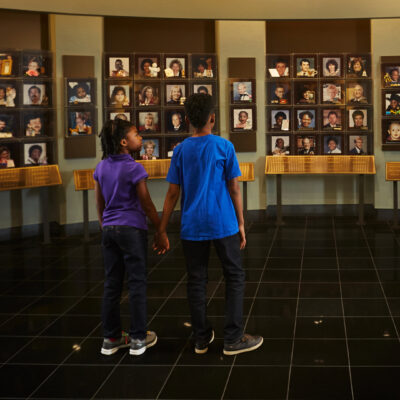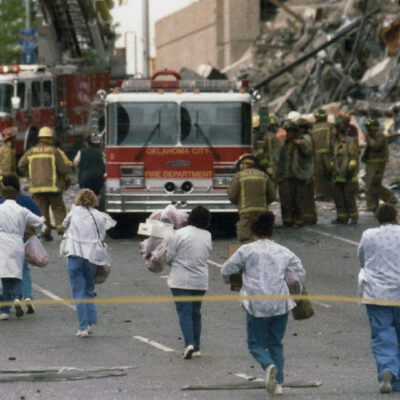Lesson Plan
Investigation: The First Days of the Oklahoma City Bombing
On April 19, 1995, at 9:02 a.m. a massive explosion destroyed the north side of the Alfred P. Murrah Federal Building, killing 168 people. Investigators soon discovered that this explosion was not from a natural gas leak or any other natural cause. It had been a deliberate act of domestic terrorism. The rescue and recovery of survivors was the first priority; however, the need to apprehend the person or persons responsible was vital. It was paramount that the perpetrators of this crime be found and brought to justice.
Lesson Summary
Students will learn the definition of terrorism, the role of the FBI, and the investigation timeline in the minutes, days, and hours following the Oklahoma City bombing. Students will simulate searching through the rubble for evidence by sifting through shredded paper for the VIN number of the Ryder truck.
- Essential Questions: How did investigators link evidence to the two men who carried out the bombing of the Murrah Building? How can the public help to solve a crime?
- Time frame: 1-2 class periods
- Subject(s): S. History, Oklahoma History, Social Studies, English
Materials Needed
- Handout: Investigating Terrorism and Understanding the FBI and Investigation Timeline
- Handout: Federal Code Indictment and Murrah Images
- Bags of “rubble”: Prior to the lesson, fill paper grocery bags with shredded paper. Each group should have one bag. Within each bag, write the VIN number (1FDNF72J4PVA26077) on one piece of shredded paper and bury it with all the other paper within the bag.
Lesson
- Show photos in handout of the Alfred P. Murrah Federal Building before and after the bombing.
- Ask students to speculate about evidence officers/investigators might have found to conclude a bomb caused the explosion. What types of evidence could be collected at the scene to help in the investigation?
- Read Defining Terrorism and Understanding the Federal Bureau of Investigation. Review Investigation Timeline.
- Discuss the critical role played by the public in helping solve the case.
- “Sifting through the rubble” activity:
-
- Each group receives a bag of “rubble.”
- Explain that one piece of shredded paper within each bag contains the VIN number from the Ryder truck. The groups are to find that VIN number in a timely manner.
- Distribute prizes to the group who finds the VIN number first and to the group who leaves the least mess, since a crime scene should stay neat and orderly.
- Ask students, “What was the most difficult aspect of searching through the paper bags? In the real investigation, the investigators didn’t know what they were looking for. How does this provide even more of a challenge?”
- Review handout United States Code – Title 18 Definitions and Federal Indictment of Timothy James McVeigh and Terry Lynn Nichols.
- Assessment: There are many everyday people who helped solve the crime of the Oklahoma City bombing. Choose one of the following people involved in the investigation and write a paragraph explaining why this person’s role was so vital in catching the perpetrators.
-
- Oklahoma Highway Patrol Trooper Charlie Hanger
- The investigator who found the axle from the Ryder truck
- Employees at Elliot’s Body Shop who provided descriptions of “Robert Kling” and the man with him
- The police sketch artist
- The owner of the Dreamland Motel, who recognized John Doe #1
- Terry Nichols’ ex-wife
Oklahoma Academic Standards for Social Studies; Oklahoma History Content Standard 5:10; grades 9-12:
Cite specific textual and visual evidence to analyze the causes and effects of the domestic terrorist attack on the Murrah Federal Building in Oklahoma City, including the responses of Oklahomans to the event, the concept of the Oklahoma Standard and the creation of the Oklahoma City National Memorial & Museum.
Oklahoma Academic Standards for Social Studies; High School U.S. History; The United States: The American Nation in Transformation, 1878 to the Present Content Standard 6:6; grades 9-12:
The student will analyze the foreign and domestic policies in the contemporary era, 1977 to the present; Evaluate the rise of terrorism and its impact on the United States including the 1995 bombing of the Murrah Federal Building, the first attack on the World Trade Center Towers in 1993, the attacks on September 11, 2001, the PATRIOT ACT, and the creation of the Department of Homeland Security.
Oklahoma Academic Standards for English Language Arts Standard 1.W.1; grades 6-12
Students will give formal and informal presentations in a group or individually, organizing information and determining appropriate content and purpose for audience.
Common Core Standards for ELA; Writing #4; grades 6-12
Produce clear and coherent writing in which the development, organization, and style are appropriate to task, purpose, and audience.
National Council for the Social Studies 10.j; grades 6-12:
Social studies programs should include experiences that provide for the study of the ideals, principles, and practices of citizenship in a democratic republic, so that the learner can recognize and interpret how the “common good” can be strengthened through various forms of citizen action.





